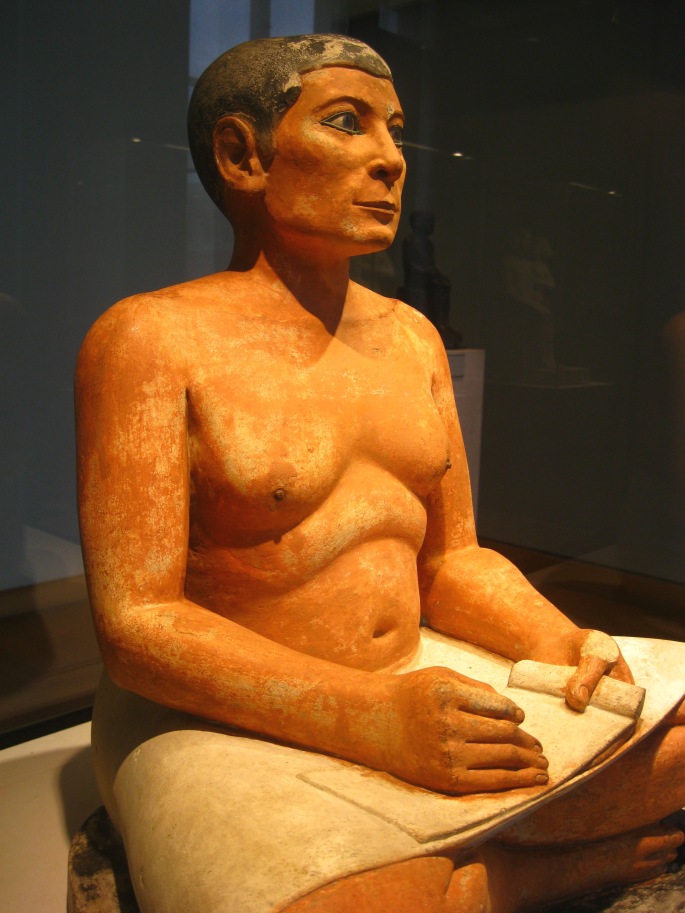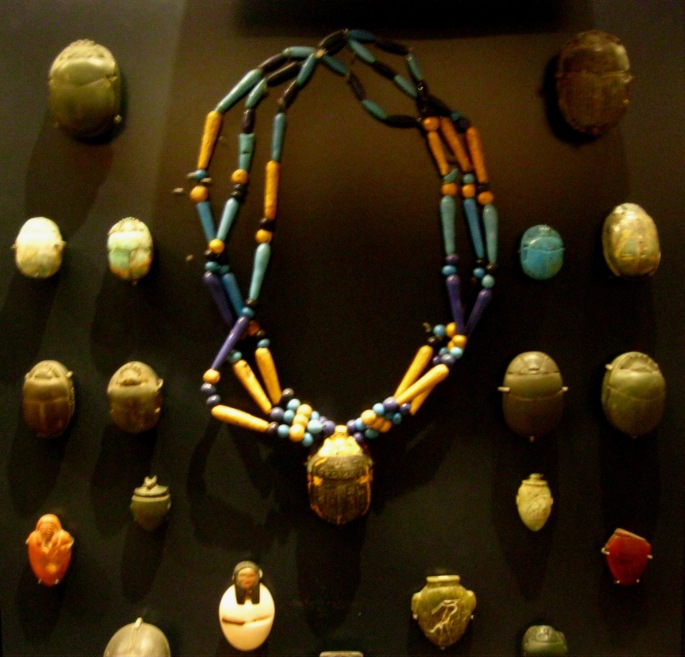After the party and dinner in the Napoleon III apartments at the Louvre, let’s move on to another department, another continent and another time period! My final stop in this fabulous museum was inspired by Ava, a loyal reader of Ritournelle. Originally from California, Ava grew up in Paris and insisted that her parents take her on monthly visits to see the mummies at the Louvre. When I read about this childhood memory in her email, I knew I had to see these treasures from Ancient Egypt for myself.
When entering the Department of Egyptian Antiquities, you are greeted by a large relief covered with mysterious hieroglyphs. What could they possibly mean?
Maybe we’d better ask the scribe.
Or even better, the Egyptian deity Thoth, scribe to the gods, depicted here as a friendly baboon.
Let’s now focus on the Ancient Egyptian burial customs. It is fascinating how the Egyptians could erect monuments like the Pyramids with their relatively basic tools. Much smaller pieces like this sarcophagus are impressive already by their engravings and mass. Stone sarcophagi were commonly used to bury wealthy Egyptians.
However Egyptians ran out of materials to build these sarcophagi and relied on wood instead. The drawings depict the activities that the deceased would enjoy in the afterlife.
Time has not erased the emotions of the deceased expressed on the inner coffins: resigned, worried about an uncertain fate, confident facing the unknown or amused by our stares.
Waiting in line
Isn’t this pattern beautiful?
And finally, the star of the Louvre Department of Egyptian Antiquities: the mummy and its mask.
Canopic jars were used to store the viscera of the deceased for the afterlife. The one with a hawk head preserved the intestines and the one with a jackal head contained the stomach.
Scarab charms played an essential role in Egyptian burial rituals. Placed on the chest, it was supposed to prevent the heart from testifying against the deceased during the judgment of the soul by Osiris.
Admiring these treasures at the Louvre is an incredible experience, but I wish I could have seen them in their original environment in Egypt!
As I exited the museum, these two intriguing pieces caught my eye. I found out they were actually antique sarcophagi from Lebanon. It is interesting to see how they were caught between two cultural influences: Egypt for their shape and Greece for the sculptures of the faces.
Ava was fascinated by Ancient Egypt in her childhood. And you, did you have a favorite time period?
Après avoir visité les appartements Napoléon III du Louvre, place à un autre département, un autre continent et une autre époque ! La deuxième partie de mon tour dans ce fabuleux musée m’a été inspirée par Ava, une lectrice fidèle de Ritournelle. Ava la Californienne a grandi en France et suppliait régulièrement ses parents de l’emmener voir les momies au Louvre. Quand elle m’a raconté ça par mail, j’ai eu envie de voir ces chefs-d’œuvre de l’Antiquité de mes propres yeux.
L’introduction au département des Antiquités Egyptiennes se fait par les mystérieux hiéroglyphes. Devinez leur signification ? Peut-être vaut-il mieux demander l’avis du scribe. Ou encore mieux, consulter Thot, le dieu des scribes ici représenté sous la forme d’un babouin bien sympathique.
Venons-en maintenant aux rites funéraires. Les Pyramides nous fascinent en partie par l’ingéniosité des Egyptiens qui ne disposaient pas d’outils sophistiqués pour leur construction. Mais je trouve qu’on peut déjà admirer ce sarcophage entièrement gravé qui doit peser un poids considérable. La pierre était un matériel destiné aux Egyptiens fortunés. Cependant, les matériaux sont venus à manquer pour la construction des sarcophages et les Egyptiens ont alors utilisé principalement le bois. Les dessins représentent les activités qu’exercerait le défunt après sa mort.
Au-delà de la beauté des cercueils admirablement bien conservés, les expressions des morts nous touchent encore à travers les millénaires : résignés à passer dans l’autre monde, inquiets de leur sort, sereins face à l’inconnu ou amusés à la vue de notre regard inquisiteur.
Et enfin, la pièce-clé des antiquités égyptiennes du Louvre : la momie et son masque funéraire. Pour être honnête, je n’ai pas tellement envie de voir ce qu’il y a sous les bandelettes… (Recherchez « mummy remains » sur Google Images et vous verrez ce que je veux dire.)
Les vases canopes étaient destinés à recueillir les viscères embaumés des défunts. Celui à tête de faucon contenait les intestins et celui à tête de chacal l’estomac.
Les scarabées étaient d’une importance essentielle dans les cultes funéraires. Déposés sur le buste, ils assuraient que le cœur ne témoignerait pas contre les défunts lors du jugement de l’âme par le dieu Osiris.
Voir ces chefs-d’œuvre de l’histoire à Paris est une grande chance, mais je regrette de ne pas pouvoir les admirer dans leur environnement initial !
En me dirigeant vers la sortie, j’ai aperçu ces pièces intrigantes. Il s’agit de sarcophages antiques du Liban. On peut y voir le croisement des influences égyptiennes pour leur forme et grecques pour la sculpture du visage.
Ava était fascinée par l’Egypte Antique quand elle enfant. Et vous, y avait-il une époque de l’histoire que vous préfériez ?























You are too sweet, Anne! Thank you so much for this post. Now I can *always* visit my ancient Egyptian friends, wherever I am.
I’m so happy that my childhood obsession helped inspire you to discover this section of the Louvre for yourself. And I totally agree with you: It would be great if we could view these treasures in their intended homes in Egypt.
This was awesome!
Hi Ava, I’m glad you liked this post and I hope it was up to your expectations ;-) Enjoy your holidays!
Ils sont incroyables ces derniers sarcophages ! Vraiment étrange de voir ces têtes plutôt “grecques” sur un sarcophage…
J’aime beaucoup l’Antiquité d’un point de vue historique, mais mon “type” d’art préféré est sans aucun doute le contemporain ! :)
Oui c’était trop bizarre, je ne connaissas pas du tout.
Et je suis d’accord avec toi : vive l’art contemporain!
Oh how i adore Ancient Egypt..Amazing pictures..thank you so much for posting the pictures (:
You’re welcome; glad you like them!
I love history particularly those of Egypt. I started reading your post on Louvre (the one which is freshly pressed, congrats for that :) ) and find out that you blog about France and will blog about New York City too (if I’m not mistaken).
Would love to read more, and by the way may I put your blog in my blogroll? I’ve listed it already but if you mind I’ll remove it. Thanks :)
Thanks for adding my blog to your blogroll, I really appreciate it! And thanks for liking this post ;-)
I saw this exhibit at the Louvre too and absolutely loved it! They have a wonderful collection there (of course, it is the Louvre after all :) ). It’s so nice to step back and marvel at all of these treasures again. Thank you!
I’ve been to many Egyptian exhibits including Tut but never have I seen the Greek influenced- thanks! I love your blog…Great pictures!!!
Thank you for your comment and for subscribing! I have to check out your blog further; I lived in Japan for a year so it must be fun to follow your family as you are settling there.
Wonderful post on the Louvre and the Egyptian Antiquities. I stumbled upon the mummy section a couple times ago when I was there and was so amazed at the condition of the mummy you took a picture of. Seeing it in person and realizing how small this person was as an adult was incredible too. We are a much bigger society now and I couldn’t imagine making a sarcophagus!
It was nice to visit it again through your pictures. I was intrigued by the sarcophages because at first I didn’t know what they were as I walked from room to room. Then when I realized what they were, I couldn’t believe the attention to detail with the carvings and paintings on the inside of them. Thanks for giving me a better explanation of the significance of the writings.
Whenever I go, I always take my guests to this area just to see the mummies.
Thanks for your comment! I didn’t notice the mummy’s size when I was at the Louvre; I’ll have to pay attention next time I go.
What other areas of the Louvre would you recommend?
I love everything! I’m a history nut! My favorite would have to be the displays of the jewels and the crowns. I got yelled at by the guards for taking a picture with a flash the first time, but in that room, the ceilings are gorgeous! The artwork on them andlooking down the never ending arched hallways makes me dream about living there!
I’ve never been to the Apartements but your post on them took me there and I am definitely going to see them next time. I like the Italian artist section only because of the size of the paintings! Absolutely enormous. Tired of seeing the Mona Lisa but I must say I was shocked at how little she was when I first saw her. Everybody wants to see the Mona so you can’t really get a good pic, at least all the times I was there.
Happy New Year ma cherie!!!!! I wish you a very good year. Lots of kisses from a cold Sweden. //F
oh the louvre, office of stolen object, what a complacent issue !
An office of “stolen” objects, like so many other museums around the world. We can not undo history, so we might as well be greateful and appreciate that we can admire such works of art without having to travel.
These are just amazing photos,awesome, its really marvelous !
thanks a lot for posting such beautiful photos :)